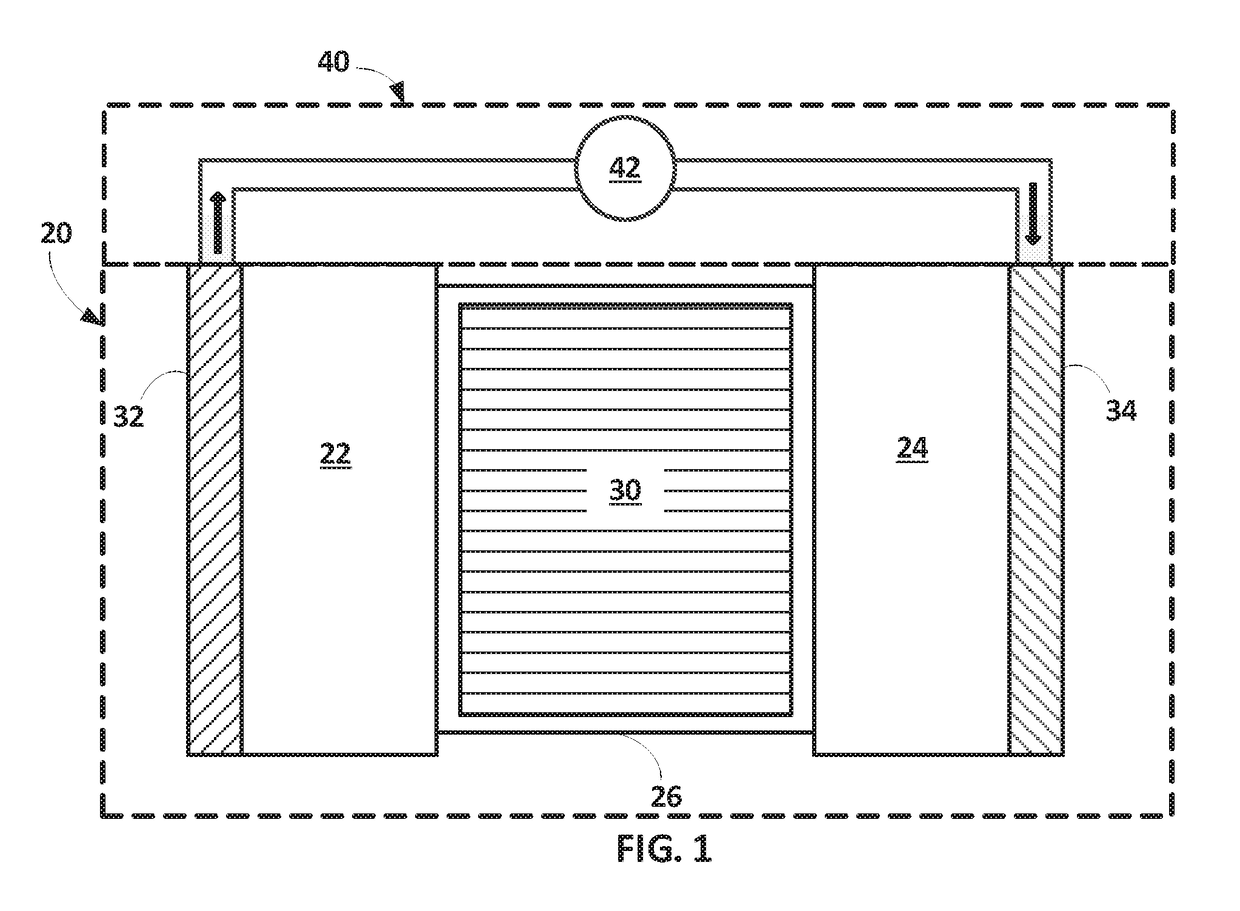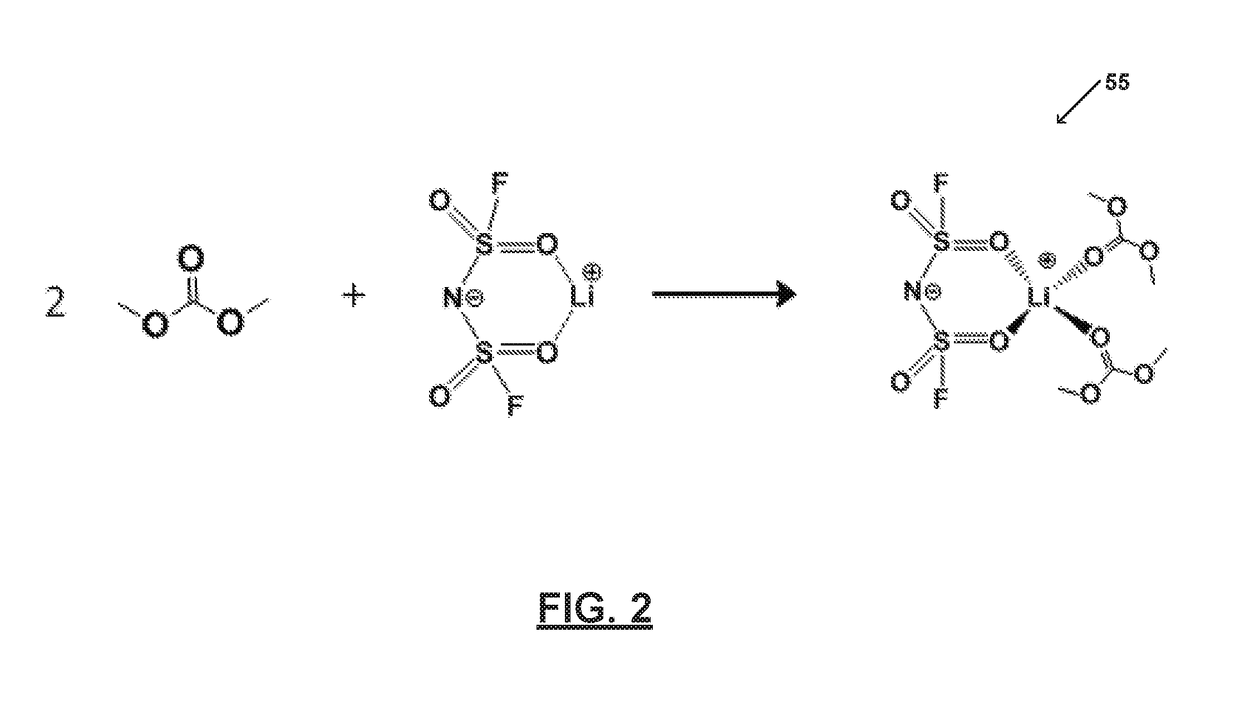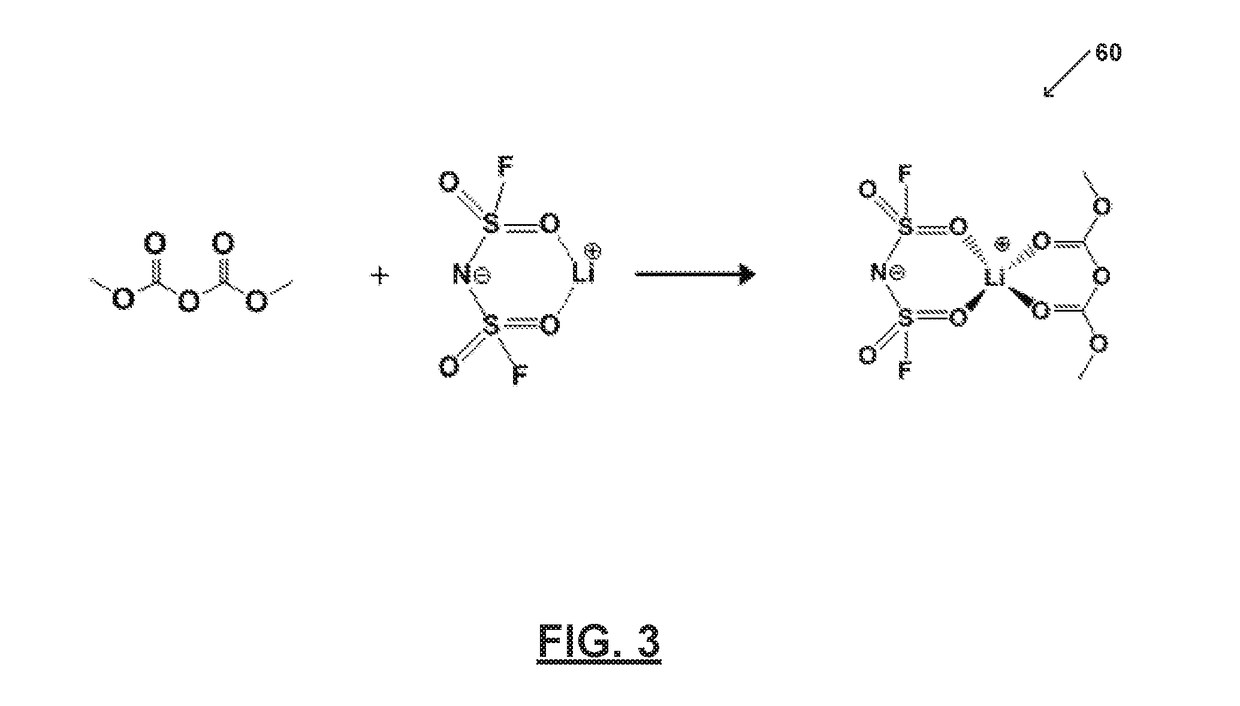Carbonate-based electrolyte system improving or supporting efficiency of electrochemical cells having lithium-containing anodes
a carbonate-based electrolyte and electrolyte technology, which is applied in the direction of sustainable manufacturing/processing, cell components, batteries, etc., can solve the problems of unreliable or diminished performance, premature electrochemical cell failure, and compromise the coulombic efficiency and cycling life of rechargeable lithium batteries, so as to reduce the risk of side reactions and increase the efficiency of batteries including electrolyte system 60
- Summary
- Abstract
- Description
- Claims
- Application Information
AI Technical Summary
Benefits of technology
Problems solved by technology
Method used
Image
Examples
example 1
[0063]FIG. 2 illustrates an electrolyte system 55 prepared in accordance with certain aspects of the present disclosure. In particular, FIG. 2 shows an electrolyte system 55 comprising one or more salts bound to a solvent to form a bound moiety. FIG. 2 shows an electrolyte system 55 comprising one or more salts bound to a solvent to form a bound moiety. Electrolyte system 55 includes a bound moiety comprising lithium bis(fluorosulfonyl)imide (LiFSI) and dimethyl carbonate (DMC). Electrolyte system 55 includes a concentration of lithium bis(fluorosulfonyl)imide (LiFSI) of about 5M and a molar ratio of the lithium bis(fluorosulfonyl)imide (LiFSI) to the dimethyl carbonate (DMC) of about 0.5.
[0064]As illustrated, all of the dimethyl carbonate (DMC) molecules bind with lithium (Li+). Thus, dimethyl carbonate (DMC) and bis(fluorosulfonyl)imide (FSI−) may be immobilized and the electrolyte system 55 may be substantially free of free or unbound dimethyl carbonate (DMC) and free or unbound ...
example 2
[0065]FIG. 3 illustrates an electrolyte system 60 prepared in accordance with certain aspects of the present disclosure. In particular, FIG. 2 shows an electrolyte system 60 comprising one or more salts bound to a solvent to form a bound moiety. FIG. 2 shows an electrolyte system 60 comprising one or more salts bound to a solvent to form a bound moiety. Electrolyte system 60 includes a bound moiety comprising lithium bis(fluorosulfonyl)imide (LiFSI) and dimethyl dicarbonate (DMDC). Electrolyte system 60 includes a concentration of lithium bis(fluorosulfonyl)imide (LiFSI) of about 5M and a molar ratio of the lithium bis(fluorosulfonyl)imide (LiFSI) to the dimethyl dicarbonate (DMDC) of about 1.
[0066]As illustrated, all of the dimethyl dicarbonate (DMDC) molecules bind with lithium (Li+). Thus, dimethyl dicarbonate (DMDC) and bis(fluorosulfonyl)imide (FSI−) may be immobilized and the electrolyte system 60 may be substantially free of free or unbound dimethyl dicarbonate (DMDC) and fre...
example 3
[0067]FIG. 3 illustrates comparative electrolyte systems 70 and 80. Electrolyte system 70 is prepared in accordance with certain aspects of the present disclosure and comprises one or more salts is selected from the group consisting of: lithium bis(fluorosulfonyl)imide (LiFSI), sodium bis(fluorosulfonyl)imide (NaFSI), potassium bis(fluorosulfonyl)imide (KFSI), and combinations thereof and a solvent comprising one or more solvents selected from the group consisting of: dimethyl carbonate (DMC), dimethyl dicarbonate (DMDC), and combinations thereof. The one or more salts have a concentration in the electrolyte system 70 of greater than or equal to about 4 M, and a molar ratio greater than or equal to about 0.5 to less than or equal to about 1. Thus, electrolyte system 70 is substantially free of unbound dimethyl carbonate (DMC), unbound dimethyl dicarbonate (DMDC), and unbound bis(fluorosulfonyl)imide (FSI−).
[0068]Electrolyte system 80 also comprises one or more salts is selected from...
PUM
| Property | Measurement | Unit |
|---|---|---|
| molar ratio | aaaaa | aaaaa |
| molar ratio | aaaaa | aaaaa |
| energy density | aaaaa | aaaaa |
Abstract
Description
Claims
Application Information
 Login to View More
Login to View More - R&D
- Intellectual Property
- Life Sciences
- Materials
- Tech Scout
- Unparalleled Data Quality
- Higher Quality Content
- 60% Fewer Hallucinations
Browse by: Latest US Patents, China's latest patents, Technical Efficacy Thesaurus, Application Domain, Technology Topic, Popular Technical Reports.
© 2025 PatSnap. All rights reserved.Legal|Privacy policy|Modern Slavery Act Transparency Statement|Sitemap|About US| Contact US: help@patsnap.com



